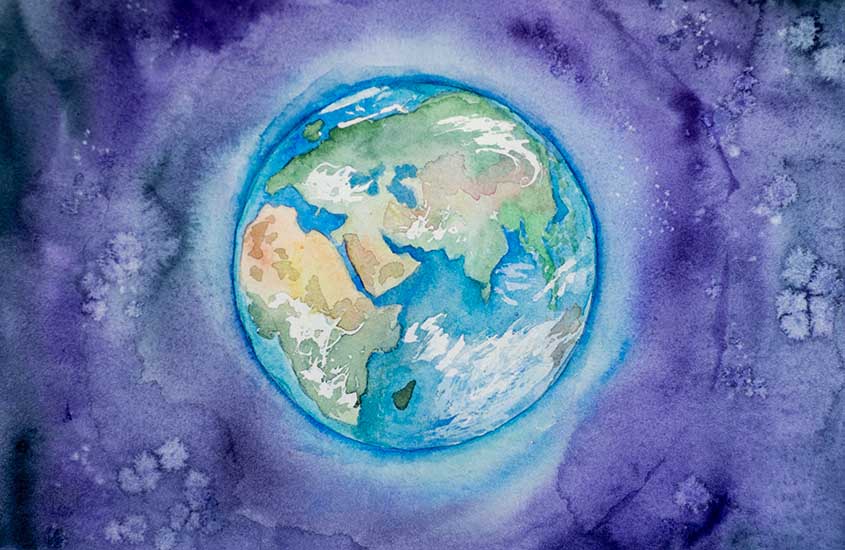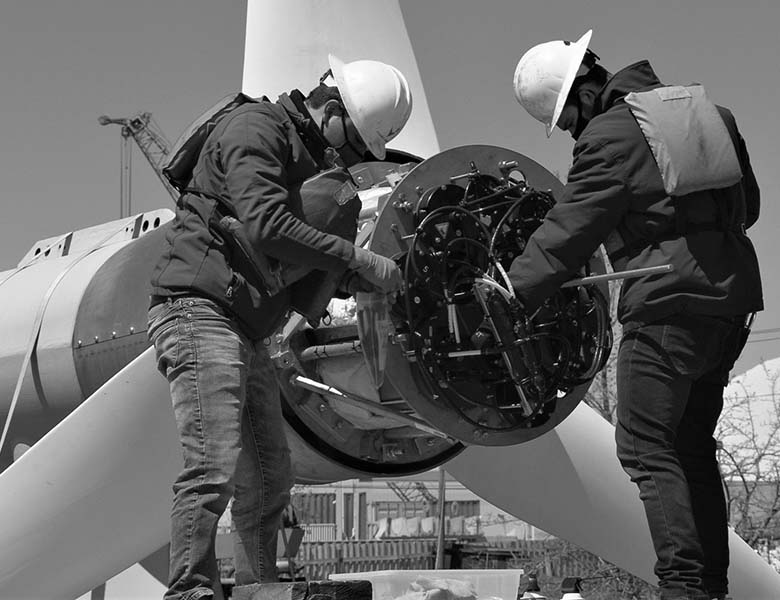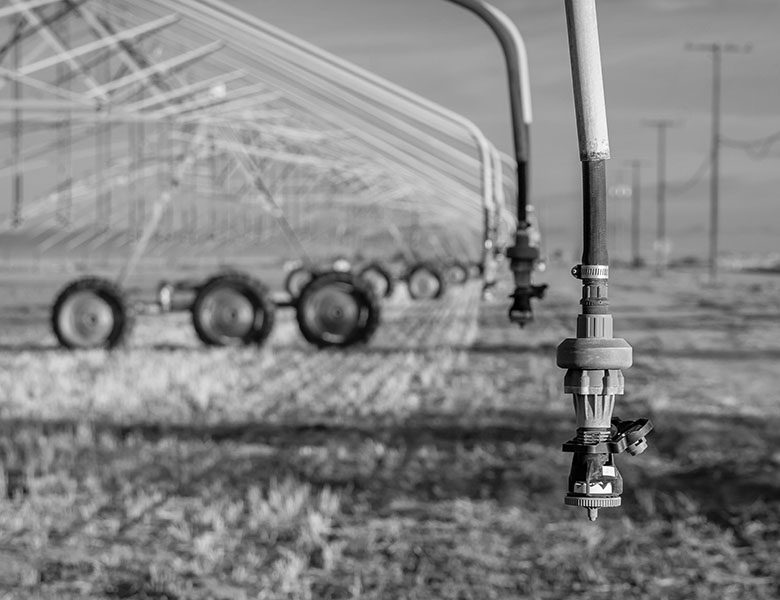How Can We Invest in Our Planet?
For Earth Day 2022, Here Are Three Ways NREL Water Power Is Investing in Tomorrow’s Cleaner World—And How You Can, Too

On America’s first Earth Day in 1970, Barry Commoner, a biologist and politician, shared some grim words: “This planet is threatened with destruction and we who live in it with death.”
Today, more than 50 years later, Commoner’s words are still true. But climate change and the destruction he spoke of can be slowed or even reversed, in part, by transitioning to clean, renewable energy, like water power, which can help reduce the pollution fouling the planet’s air and water. Commoner—and the two-thirds of Americans who want more federal action to fight climate change—might be happy to see historic investments in clean, carbon-emission-free energy, including hydropower and marine energy, but there is still much work to be done—by all Americans.
For their part, researchers at the National Renewable Energy Laboratory (NREL) are investing their careers to create the clean energy needed to clean up the planet. To celebrate the 2022 Earth Day theme, “Invest in Our Planet,” here are four ways NREL is investing in water power to build a reliable foundation for a future renewable energy world—plus, easy investments every American can make to help preserve the planet for future generations.
Reduce Plastic Pollution

In April 2021, NREL researchers worked with Verdant Power to install the laboratory's recyclable thermoplastic blades onto the company's tidal turbine. Here, Verdant Power workers prepare the turbine for its first real-world trial in New York City's East River. Photo By David Dawkins
Microplastics have been found in rain, fish, salt, tap water, and even beer. The oceans suffer the most; about 14 million tons of plastic—equivalent to the weight of almost 3 million elephants—flows into the world’s seas. These plastic bottles, bags, and microbeads not only threaten marine wildlife (which can get entangled or mistake the plastic for prey), but also eventually return to their creators in the food and beverages we humans ingest.
What NREL Is Doing
While some NREL researchers are coming up with clever ways to manufacture, recycle, or break down plastics (such as with plastic-eating bacteria), the laboratory’s water power researchers are designing a multipurpose plastic that could help generate more clean energy and can be recycled, too.
Tidal turbines, which look like mini underwater wind turbines, can generate clean marine energy from the power of rushing tides. Made with a tough kind of plastic, their turbine blades are designed to be hardy even in salty, turbulent waters, so they can churn out pollution-free energy for years. But that tough plastic comes with an end-of-life downside; it is so darn hardy it is not recyclable.
So, NREL researchers invented a new kind of plastic, called thermoplastic resin, which can be used to build blades for both wind and tidal turbines. Durable enough to keep that clean energy flowing longer than traditional resins, this new material can be melted down and reused (or melted and patched, so they can last even longer). As a bonus, NREL’s thermoplastic resin might perform better than their one-use counterparts, producing more clean energy for a cleaner future.
What You Can Do
Simple: Use as little plastic as possible! Here are a few less obvious ways to keep plastics out of the oceans and humans' bodies, too:
- It bears repeating: Use less! In most of the country, most types of plastics are not recyclable. In 2017, only about 8% of plastic waste got recycled, according to the Environmental Protection Agency. So, recycle what you use but use as little as possible, too!
- If you must use plastic bags, give them back. While plastic bags, wraps, and films are recyclable, they cannot go in household bins. But some retail and grocery stores will recycle these on your behalf—find a store willing to take yours!
- Follow NREL’s lead and reuse the plastics you need. Wash them. Repurpose them. Or, if you are really motivated and crafty, turn them into gardens, bookcases, or blankets.
Save Water—and Energy Along With It

NREL researchers are examining how hydropower can serve tomorrow's clean energy grid while providing other critical services, like irrigation for farmers and water management. Photo from Steve Harvey, Unsplash
“The world needs to get water smart,” UNICEF warned in a recent article. “Around 74% of natural disasters between 2001 and 2018 were water related, including droughts and floods.” As the climate changes, dry regions are likely to get drier, and wet ones wetter, increasing the risk of both droughts and flooding. Plus, as fresh water supplies shift and shrink, that affects far more than available drinking water; power plants, farms, and other industries need water to run safely, if at all.
What NREL Is Doing
While most Americans know hydropower as a clean and reliable energy source, it serves far more than the power grid. In drought-prone regions, for example, hydropower reservoirs can help communities manage their water supplies; in damp areas, those reservoirs can absorb dangerous floods before they reach towns and cities. At NREL, researchers are examining all of hydropower’s many auxiliary benefits, including irrigation and affordable energy for farmers as well as cooling water (and a bit of extra clean energy) to keep power plants up and running.
And, to keep electricity running even during blackouts caused by extreme weather or cyberattacks, the country can depend on pumped storage hydropower plants, which can house renewable energy in large lakes for future use. Pumped storage hydropower already provides more than 90% of the United States’ energy storage for the grid, and NREL’s hydropower experts are examining how these Earth-friendly plants could partner up with other methods of energy storage, like lithium-ion batteries, to keep tomorrow’s grid running smoothly.
What You Can Do
You have already been told, over and over, to take shorter showers, so here are a few other ways to conserve water:
- Recycle and reuse rainwater and “greywater.” Household water from bathroom sinks, showers, and washing machines can be reused to water your lawn and garden; but make sure to follow local restrictions.
- Wash clothes in bulk and cold water. Only running your clothes washer when full is a great way to save water—and money, too.
- Live in the desert? Plant a xeriscape garden. These hardy, drought-resilient plants set a stellar example of how to adapt to a resource-scarce environment and take only the water they need.
Build Resilient Communities

Remote American communities often have the highest energy prices and least-reliable energy systems in the country. Through the Energy Transitions Initiative Partnership Project, NREL researchers work alongside these communities—like Alaskan villages situated deep in the state's vast wilderness—to transform their energy systems and increase their resilience to energy disruptions, extreme weather events, and climate change. Photo from Paxson Woelber, Unsplash
Today, many remote and islanded communities, including the Hawaiian Islands and Alaska’s coastal villages, must ship in expensive fossil fuels to generate electricity. That is not the most sustainable option for their coffers and climate—nor is it reliable. What happens if a storm trundles in and prevents those fuels from arriving?
What NREL Is Doing
NREL is helping these isolated communities harness a bountiful renewable resource flowing right past them: water. Partnering with the U.S. Department of Energy through its Energy Transitions Initiative Partnership Project, the laboratory offers technical assistance to towns and villages. This includes helping them build better or new energy infrastructure that can generate clean, affordable, and locally sourced water power from their rivers and oceans. In Dillingham, Alaska, for example, residents are exploring run-of-river hydropower, which creates energy from a river’s natural flow (and without a dam). And in Eastport, Maine, where extreme weather causes frequent outages, inhabitants are hoping to harness the huge tidal energy flowing through their islands—with NREL’s expert help.
What You Can Do
Want an easy way to help your community become more energy resilient? Simply reduce your electricity use; unplug vampire electronics, embrace sunlight, and get energy-efficient everything. Want to invest more? Here are few ways you can help build a more energy and climate-resilient America:
- Work with your community leaders to transition to renewable energy. And encourage them to apply to the Energy Transitions Initiative Partnership Project to receive help from NREL or another national laboratory.
- Spread the love of water power. If your community is already on its way to 100% carbon-free energy, then help empower others—explore a career in hydropower or marine energy.
Protect Marine Wildlife and Ecosystems

Over a million species, including humans, need healthy oceans to survive. Through the Powering the Blue Economy initiative, NREL's researchers aim to harness the ocean's immense power to generate the clean energy needed to monitor and safeguard these waters. Photo by the Department of Energy's Water Power Technologies Office
From sea lions to octopuses, dugongs to plankton, the world’s oceans are home to close to a million species, if not more. And yet, about 80% of these waters have yet to be explored. They are also changing along with the climate. As temperatures and greenhouse gases rise, oceans absorb both heat and carbon dioxide, warming and acidifying. These changes could shrink marine ecosystems, forcing marine wildlife to compete for less space and prey. That is not good for humans, either; about 20% of the world depends on fish as a food source.
What NREL Is Doing
NREL’s researchers are helping power ocean exploration while protecting these waters from additional harm. Through the U.S. Department of Energy Water Power Technologies Office’s Powering the Blue Economy initiative, the laboratory is guiding the development of ocean-bound technologies powered by nothing but the briny deep—more specifically, its rolling waves, currents, and tides. Autonomous underwater sea drones, for example, could collect data on marine wildlife and ecosystems to monitor their health. Wave-powered buoys can watch for signs of brewing tropical storms. And desalination devices can provide clean drinking water for coastal communities and disaster recovery using nothing but the power of the ocean.
What You Can Do
Here are a few ways you can dip your toes into supporting the ocean’s wildlife and ecosystems:
- Use less fertilizer. These chemicals can wash into rivers and down into the oceans, creating “dead zones” where little but fertilizer-fed algae can survive.
- Choose sustainable seafood for you and your cat. Check out FishWatch, the nation’s database of sustainable seafood, to see which species need protection, and read cat food labels to make sure your kitties are doing their part to protect marine wildlife.
- Be green when you head to the seas. For salty folks who cannot stay away from the waves, remember to be responsible out in the water. Look out for marine critters and choose ecofriendly vehicles, like kayaks or maybe, in the not-too-distant future, a wave-powered boat.
If every American invests in the planet, the nation could easily achieve the Biden administration’s goal of net-zero carbon emissions by 2050. Then, on Earth Day 50 years from now, we could finally rewrite Barry Commoner’s words to read: “This planet was threatened with destruction, and we who live in it saved it.”
Learn more about how NREL water power is investing in the planet. Also, do not miss out; subscribe to the NREL water power newsletter, The Current.
This article has been updated to reflect an editorial change made after its original publication.
Last Updated May 28, 2025
